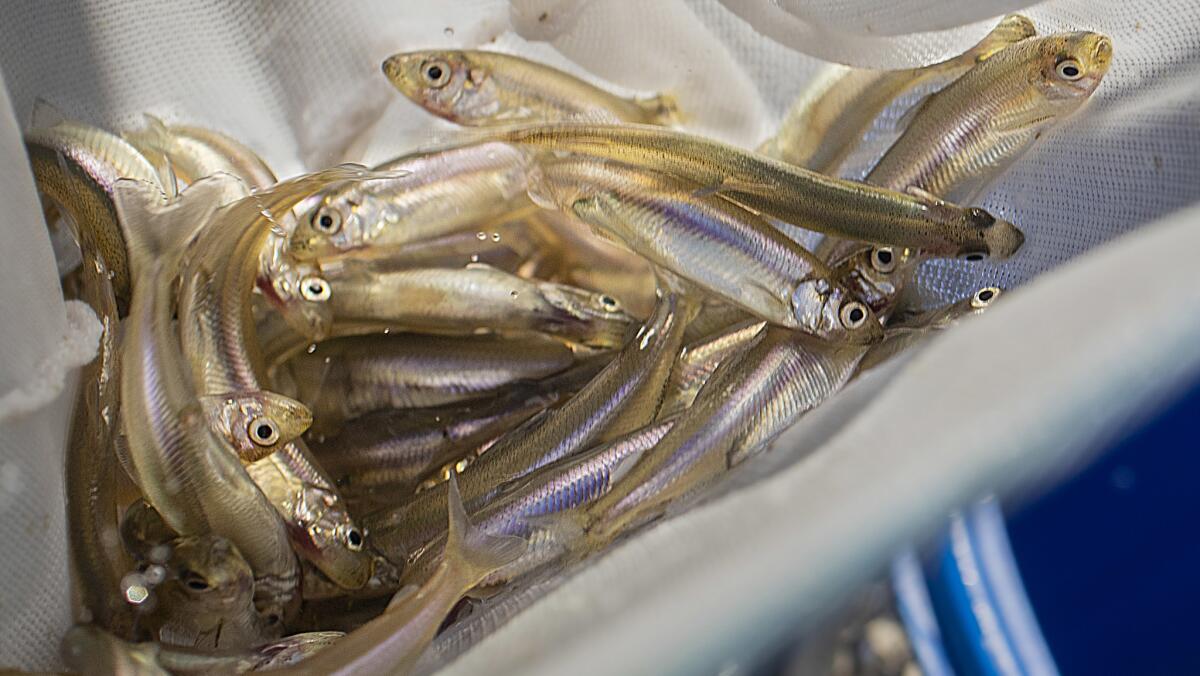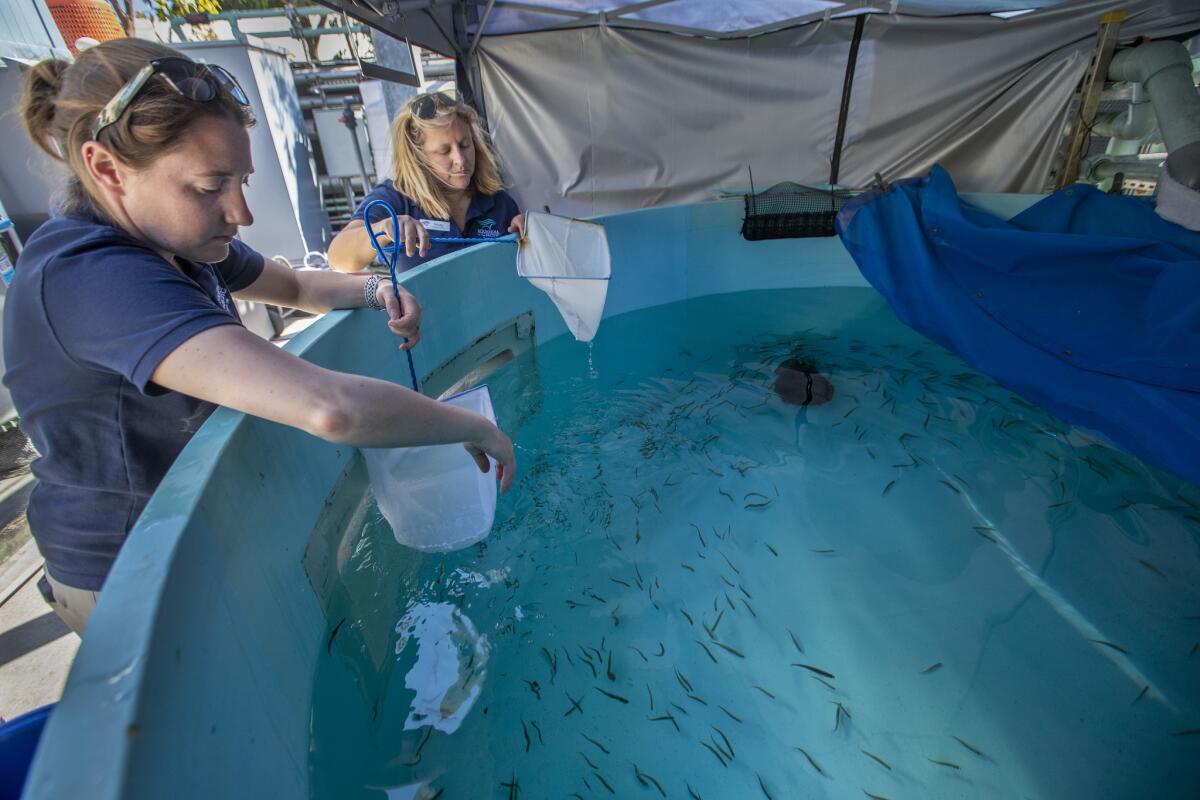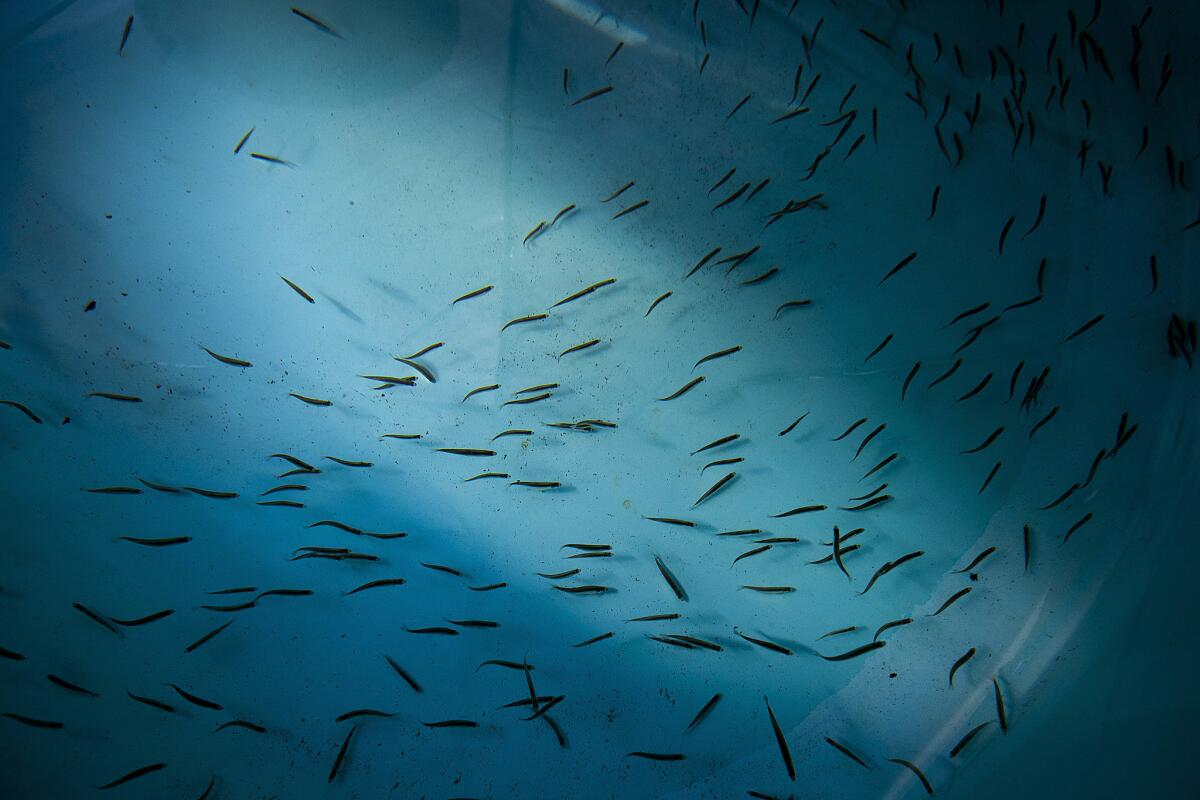As California’s delta smelt spirals toward extinction, a future in captivity awaits

Time may be running out for California’s most infamous fish.
Despite a decades-long rescue effort, the tiny delta smelt appears closer than ever to vanishing from its only natural home, the Sacramento-San Joaquin Delta.
Now, some worry it won’t be long before the only place the once-abundant species exists is within the confines of an artificial tank.
“If current trends continue, and we don’t get the numbers back up in the wild this year, we will be at a point where the only ones left will be in captivity,” said Peter Moyle, an expert on the species at UC Davis.
Mocked by President Trump as “a certain kind of three-inch fish” and targeted by endless litigation, Hypomesus transpacificus has struggled to survive within the heart of a delicate and overtaxed water distribution network.

Efforts to preserve the smelt have relied on restricting delta water operations supplying the San Joaquin Valley and Southern California — regulations that have vexed agricultural interests and water districts, and placed the fish squarely in the center of California’s water wars.
Most recently, the smelt played a supporting role in calls to open an ethics investigation into newly confirmed Interior Secretary David Bernhardt. As a lobbyist for California’s Westlands Water District — the largest agricultural water supplier in the nation — Bernhardt argued in favor of weakening federal protections for the smelt and other species.
The prospect of extinction may seem unduly pessimistic to some, but the Aquarium of the Pacific in Long Beach announced recently that it had acquired 1,200 delta smelt from a UC Davis research hatchery.
The fish will be exhibited in a 6-feet-tall, 6-feet-wide acrylic tank beginning May 24, when the aquarium opens a new $53-million wing, Pacific Visions. It would be the first such aquarium exhibit to feature the finger-length, translucent fish.
“We expect some folks to ask, ‘Why did they devote such a big beautiful place to such a teensy fish?’” said Jerry R. Schubel, president and chief executive of the aquarium.
Puzzled visitors, he said, would “go on to learn how the life cycle of the delta smelt is intertwined with the past, present and future of California’s food and water story.”

Biologists who track the delta smelt report that its numbers have declined more than 90% over the last five decades. The California Department of Fish and Wildlife for the first time turned up zero delta smelt while conducting its annual autumn survey. Other recent surveys have caught fewer than two dozen fish, scientists said.
The delta smelt’s current predicament stems largely from the rise in delta water exports, which have degraded the delicate estuary system it calls home — an environment where incoming saltwater from the San Francisco Bay mixes with out-flowing freshwater from the Sacramento and San Joaquin rivers.
Spawning occurs from March to May, when delta smelt migrate upstream to shallow freshwater in the upper delta. Females lay about 2,000 eggs, which sink to the bottom and adhere to rocks, gravel and submerged vegetation. The eggs hatch in 9 to 14 days, and within six months the juveniles reach full length.
A year after hatching, they return to the shallows to spawn and die. That is, if they live that long.
Scientists are hoping that freshwater dropped during this winter’s unusually heavy rainy season will result in an uptick in the number of delta smelt.
“Delta smelt are at the lowest levels we’ve ever seen,” said Carl Wilcox, delta policy advisor for the state Department of Fish and Wildlife. “But we haven’t yet reached the point where we’d recommend building a hatchery capable of producing enough of the fish to make it feasible to reintroduce them to the wild.”
Such an endeavor, he said, would cost about $20 million, with no guarantee of success because delta smelt reared in carefully controlled captive conditions quickly lose the instinctual survival traits they need to escape predators and to locate freshwater spawning beds.
The Aquarium of the Pacific’s delta smelt were part of a captive population at the UC Davis Fish Conservation and Culture Laboratory, about 20 miles west of Stockton. It is one of two California facilities certified by state and federal authorities to rear the species.
The best of modern hatchery science and an annual budget of $2 million funded, in part, by state and federal wildlife agencies, has been brought to bear at the facility to create a genetically pristine population as a safeguard against extinction.
The results are impressive.
“We currently maintain a healthy captive population of about 250,000 delta smelt of all age groups,” said Tien-Chieh Hung, director of the hatchery, which is located near a gate that diverts delta water into the California Aqueduct.
Standing on a berm overlooking the transfer point for water used by generations of Californians to raise corn, pears, sugar beets and asparagus, Hung said he still held out hope that the smelt would continue to exist in the wild — despite the challenges.
Reintroducing fish reared at his facility is out of the question.
“We are not able to do any reintroductions of cultured fish in the wild,” he said. “That’s because you don’t want to risk contaminating native populations with cultured fish, or possibly infect them with a disease.”
Beyond that, state officials say a viable reintroduction program would require construction of a facility capable of producing millions of delta smelt each year under a plan agreed upon by otherwise contentious stakeholders.
But time is running out.
“We are afraid if we don’t do something soon,” Hung said, “they’ll be gone forever, if it’s not too late already.”
More to Read
Sign up for Essential California
The most important California stories and recommendations in your inbox every morning.
You may occasionally receive promotional content from the Los Angeles Times.









